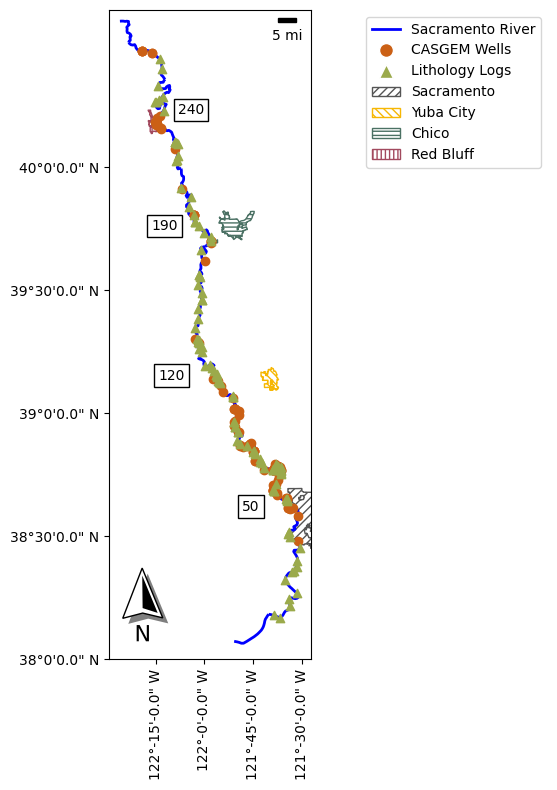Methods#
Description of the tools and techniques used to solve the problem stated in the introduction
Stream nodes and their corresponding simulated groundwater heads obtained from CV2SIM-FG v1.5
A streamline for the Sacramento River was prepared by connecting C2VSIM-FG v1.5 stream nodes. [California Department of Water Resources, 2025].
Groundwater table elevations were calculated equal to the simulated groundwater head of the highest layer where the head was above the layer bottom elevation, for each stream node and timestep.
Lithology logs were obtained from DWR’s Airborne Electromagnetic Survey (AEM) for survey areas 6 [California Department of Water Resources, 2023] and 7 [California Department of Water Resources, 2023]. Only logs labeled as high quality (HQ) were used.
Textures described in the AEM lithology logs were grouped into broader categories to reduce the number of patterns necessary for displaying them in the transects. The grouping was conducted according to the following table:
Texture
Plotting Group
Boulders
Gravel
Clay
Clay
Cobbles
Gravel
Gravel
Gravel
Rock - Intrusive
Rock
Rock - Metamorphic
Rock
Rock - Sedimentary
Rock
Rock - Undifferentiated
Rock
Rock - Volcanic
Rock
Sand
Sand
Silt
Silt
Soil
Soil
Unknown
Unknown
Measured groundwater levels were obtained from CASGEM [California Department of Water Resources, 2025]
CASGEM and lithology wells within 500 m (1,640.42 ft) from the Sacramento River streamline were projected to the streamline and used for the analysis.
Observation wells overlap in the transect were solved based on the following criteria:
For multicompletion wells, the shallowest piezometer was selected. If the shallowest piezometer was too shallow (less than 20 ft) the next one in depth order was chosen.
Observation wells were prefered over irrigation and domestic wells
Shallow wells were preferred over deep wells.
Where all the overlapping wells were shallow observation wells, the projected distance into the transect was manually adjusted to make the labels for both wells visible
Bathymetry was sampled at C2VSIM-FG v1.5 stream nodes along the Sacramento River from [Yurok Tribe and US Bureau of Reclamation, 2024] and [Wang et al., 2019].
We selected 190 mi between Sacramento and Red Bluff for our analysis. This section was divided into three transects for ease of plotting. Transect distances are reported in miles upstream from the confluence between the Sacramento River and the San Joaquin River.
The southern transect spans from miles 50 to 120, approximately corresponding to the latitudes of Sacramento and Yuba City.
The central transect spans from miles 120 to 190, approximately corresponding to the latitudes of the Yuba City and Chico boundary.
The northern transect spans from miles 190 to 240, approximately corresponding to the latitudes of Chico and Red Bluff.
The data processing was carried out in Python using libraries rasterio [Gillies and others, 2013], shapely [Gillies et al., 2025], pandas [McKinney, 2010], geopandas [Jordahl et al., 2020], and numpy [Harris et al., 2020]. Animated transects and maps were plotted using matplotlib [Hunter, 2007]. Deployment was handled using jupyter book [Executable Books Community, 2020] and GitHub Pages [GitHub, n.d.].

Fig. 1 Sacramento River and selected CASGEM wells and lithology logs. Distance along the Sacramento River from the confluence with the San Joaquin River at transect sections boundaries are shown in white boxes in units of miles.#
